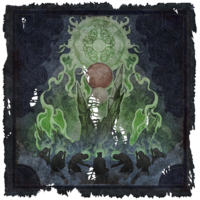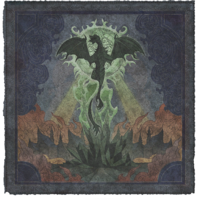Lore:Prophecy of the New Moon
The Prophecy of the New Moon was an ancient Moon-Singer song which predicted the coming of a time when a new moon, and god, known as the New Moon, or the Dark Aeon, would rise to take it's place in the sky. It described the ascension of a third moon which would be greater than both Jode and Jone, presaging an era of darkness and the birth of a new supreme being. Because of the danger the myth posed to the religious status quo of Elsweyr, it was declared forbidden within Khajiiti culture, and would remain largely secret until 2E 582, when a new incarnation of the Order of the New Moon would attempt to spread knowledge of the legend and bring about it's realization. [1]
History[edit]
Late Merethic Era[edit]
In the late Merethic Era, when Elsweyr still comprised of sixteen kingdoms, the mighty Kaalgrontiid and his rage of dragons flew to that land, seeking to establish their own domain and absorb the power of the moons, an act which Kaalgrontiid believed would allow him to achieve apotheosis as the equal of Akatosh and fullfill the Prophecy of the New Moon.[2] Kaalgrontiid would pursue the realization of his grand ambition from a temple on the island of Dragonhold, his seat of power, where his Khajiit followers would raise a number of tapestries depicting him achieving his desired ascension.[1]
The ambitions of the dragons would be thwarted when the Khajiit hero and demigod, Khunzar-ri, brought together four champions to challenge them: Nurarion the Perfect, Flinthild Demon-Hunter, Anequina Sharp-Tongue, and Cadwell the Betrayer.[3]
After days of terrible fighting where neither side managed to achieve victory, Cadwell the Betrayer, finally came up with a plan to use the dragon's ambition against them. Khunzar-ri and his companions, his Kra'Jun, feigned surrender, and Anequina Sharp-Tongue performed the Shadow Dance to align the moons into an eclipse, opening the Moon Gate of Anequina, allowing the dragons to reach the Plane of Jode and the lunar power they'd been seeking.[3] Khunzar-ri convinced the dragons to not simply absorb the lunar core, but rather combine their own life force with it, claiming that in doing so they'd combine the power of the moons with their own[4][5] This resulted in the core imprisoning most of their life force instead and, greatly weakened, the dragons were deceived into entering the Halls of Colossus, where they'd remain for millenia as the "Demon Weapon" of legend.[3]
Second Era[edit]
Following the retrieval of the Dragonstone and inadvertent release of the dragons from the Halls of Colossus by Abnur Tharn in In 2E 582, Kaalgrontiid and his rage of dragons continued pursuing the fulfillment of the prophecy once more.[6] The dragons initially allied themselves with the army of Euraxia Tharn, usurper queen of Rimmen, but soon swayed the Euraxian necromancers to serve them alone, abandoning the queen to be overtrhrown by the Elsweyr Defense Force.[7]
Kaalgrontiid had Zumog Phoon, leader of the necromancers, restore the life of Cadwell the Betrayer who, wishing to share in the lunar power and the dragon's rule, used the Shadow Dance to open the Moon Gate of Anequina, allowing Kaalgrontiid to attempt to devour the Core's energies.[8][9] The attempt was foiled by the Vestige, Abnur Tharn and Khamira, who used the Core to banish Kaalgrontiid from the Plane of Jode and into the Void,[9] but the dragon amassed incredible power, consisting primarily of the lifeforce of his fellow dragons and a lesser amount of lunar energy,[10] enough to make his way back to Nirn.[11]
Kaalgrontiid eventually made his way to Pellitine, where he tasked his ally Laatvulon and Laatvulon's chosen Dragon Priest, Ra'khajin, to reconstitute the Order of the New Moon, and set about gathering massive quantities of Aeonstone.[12][13][14]
After Laatvulon's defeat Kaalgrontiid, who'd increased his power further by devouring the sacrificed life force of the New Moon cultists amplified by the amassed Aeonstone, attempted one last plan to achieve apotheosis and fulfill the prophecy.[14] Kaalgrontiid performed a great ritual to funnel his amassed energy into an immense quantity of Aeonstone gathered at Dragonhold island, amplifying the power continuously until he achieved apotheosis and ascension to the sky as the New Moon. Through the combined efforts of the dragon Nahfahlaar and the Vestige empowered by the Mask of Alkosh, Abnur Tharn, Sai Sahan and Queen Khamira, Kaalgrontiid was ultimately slain and Dragonhold was destroyed in a massive explosion unleashed by the concentrated energy, contained to the island through the seeming sacrifice of Abnur Tharn, who stayed behind to prevent the blast from destroying Tamriel itself. [15][1]
Gallery[edit]
Notes[edit]
- According to Ja'darri, Forgotten Mane and champion of the Pride of Alkosh, the successfull apotheosis of the New Moon would lead to the tapestry of time itself unraveling, which would result in nothing being left, as all things exist within time's domain.[16]
- The dragon Nahfahlaar expressed some skepticism over whether Kaalgrontiid could have truly achieved apotheosis and fulfilled the New Moon prophecy through the means he used, but believed he was so dangerous he had to be stopped regardless.[17]
- A text by a Khajiit Moon-Priest, transcribed by a scholar of the Mages Guild suggests that dragons, Clan Mothers of the Pride of Alkosh, and Pridehome exist in some sense outside the tapestry of time and of linear progression, and so have always existed and will always exist. Consequently, the "Doom to Come" the time when dragons return to bring imbalance to the world, will also always exist. The text mentions this now also applies to Abnur Tharn.[18]
- A new moon and god would eventually rise to the sky in the Third Era, with the apotheosis of Mannimarco in the form of the Necromancer's Moon during the Warp in the West. However the Necromancer's Moon exists in opposition to the laws of Arkay rather than Akatosh, and there is no known connection between it and the New Moon of the prophecy. [19] [20][21][22]
References[edit]
- ^ a b c Abnur Tharn's dialogue during New Moon Rising in ESO: Dragonhold
- ^ Kaalgrontiid's dialogue in ESO: Elsweyr
- ^ a b c Khunzar-ri and the Demons
- ^ Cadwell's dialogue in ESO: Elsweyr
- ^ Khamira's dialogue in ESO: Elsweyr
- ^ Events of The Halls of Colossus in ESO: Elsweyr
- ^ Events of Two Queens in ESO: Elsweyr
- ^ Events of Cadwell the Betrayer in ESO: Elsweyr
- ^ a b Events of Jode's Core in ESO: Elsweyr
- ^ Nahfahlaar's dialogue during of New Moon Rising in ESO: Dragonhold
- ^ Abnur Tharn's dialogue during The Heir of Anequina in ESO: Elsweyr
- ^ Trial Master Zayri's dialogue in ESO: Elsweyr
- ^ New Cult or Ancient Religion? — Sulema, Initiate Scholar of the Pa'alatiin
- ^ a b Abnur Tharn's dialogue during The Dark Aeon in ESO: Dragonhold
- ^ Events of New Moon Rising in ESO: Dragonhold
- ^ Ja'darri's dialogue in ESO: Dragonhold
- ^ Nahfahlaar's dialogue during of The Pride of Elsweyr in ESO: Dragonhold
- ^ Pridehome: A Place Outside Time? — Kaalaleth of the Mages Guild
- ^ Lives of the Emperors — Niso
- ^ Necromancer's Moon
- ^ Journey to Aetherius quest in Daggerfall
- ^ Arkay the Enemy — KW
|
||||||||||||||||||||||||||||||||

